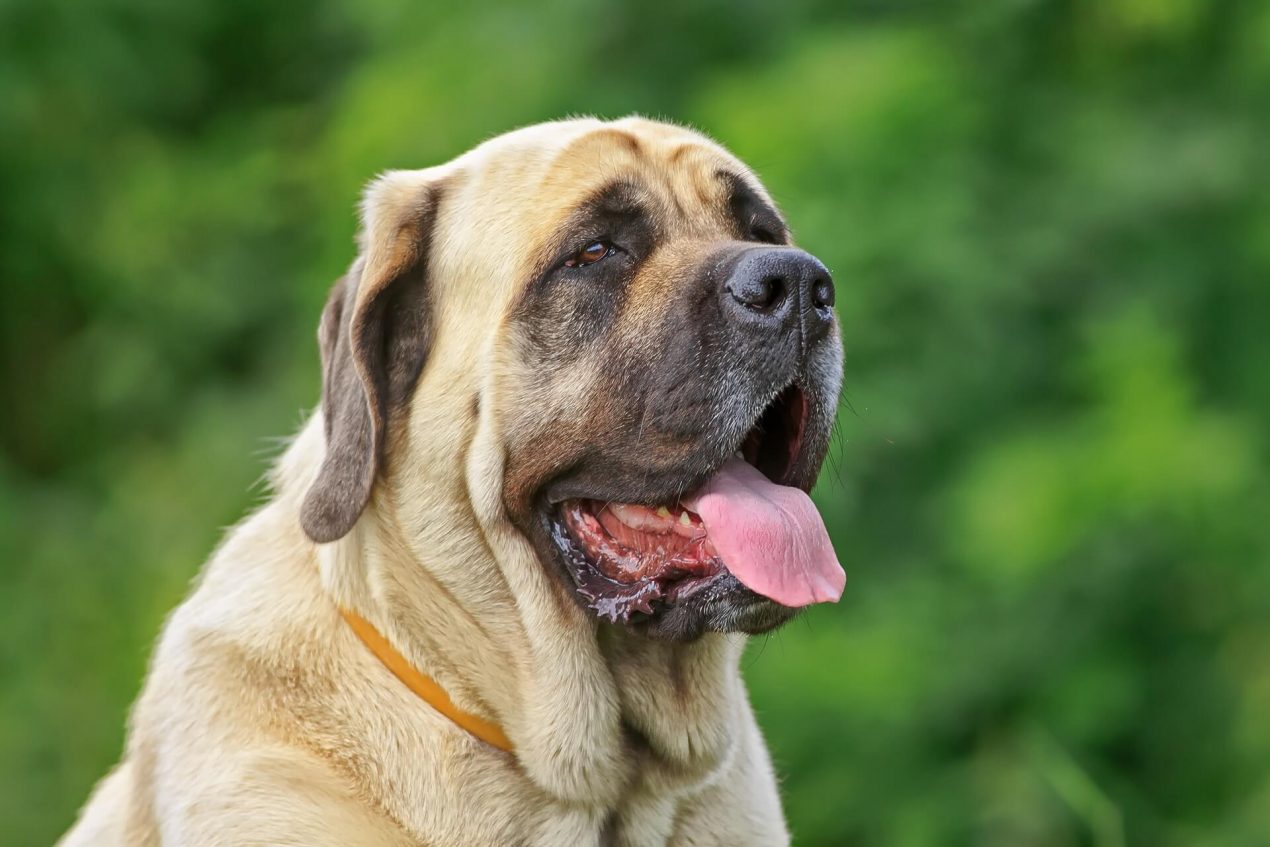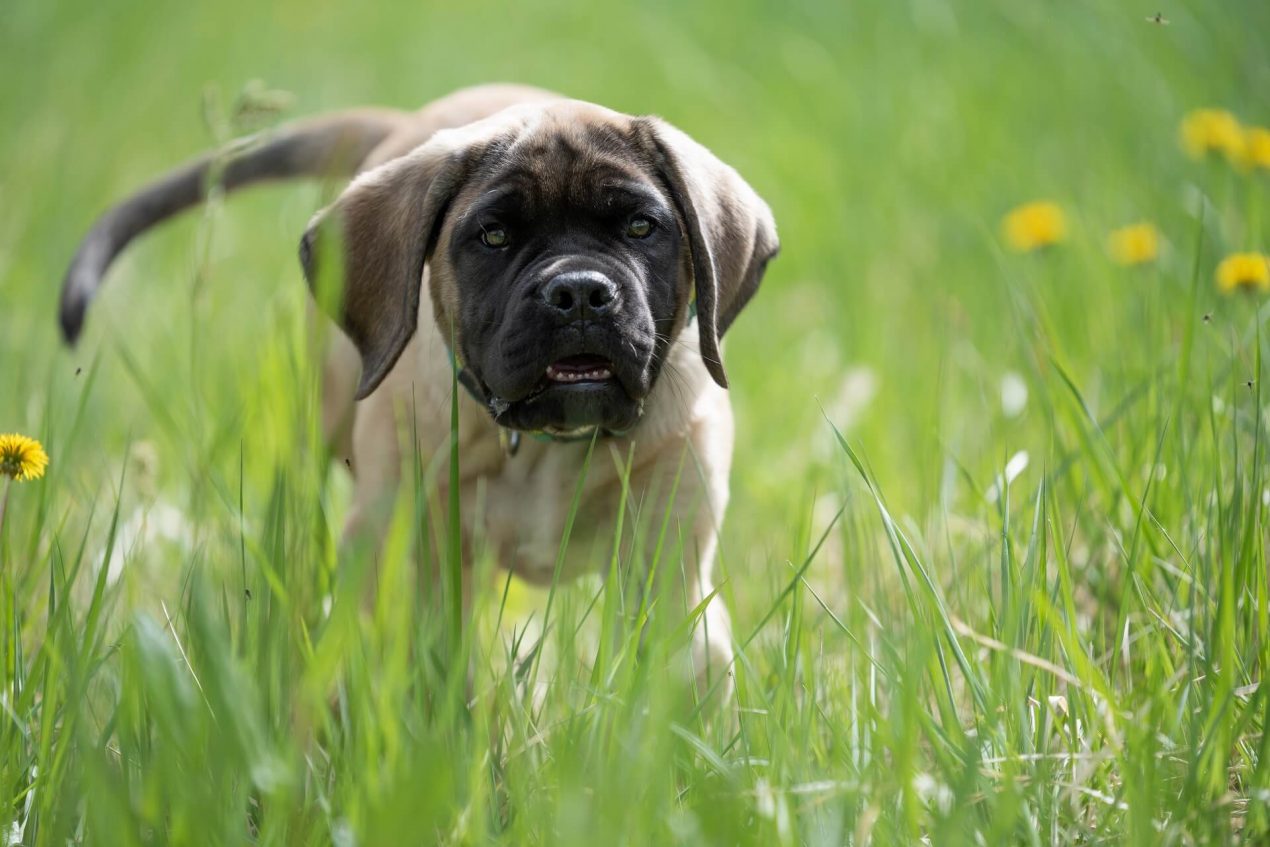At first glance, the huge Mastiff may seem intimidating, causing many to cross the street when one of these impressive dogs approaches. However, this perception overlooks the imposing dog’s true nature. While it may be one of the largest dogs, it is characterized by gentleness and patience. Its exceptional sensitivity has led to an increasing role as a therapy dog.
History of the Mastiff
Mastiffs are considered one of the oldest dog breeds in the world. Large, muscular dogs accompanying humans in hunting or war were depicted on reliefs from ancient Babylon over 2,000 years before Christ. In the Roman Empire, Molossers, as the ancestors of Mastiffs were called, served as war and hunting dogs. Additionally, historical records indicate that these dogs fought in arenas and guarded their owners’ homes.
During that time, Molossers were known and used throughout the Roman Empire and beyond through trade relations. Presumably, the ancestors of Mastiffs reached Britain through this route. The Mastiff was first mentioned by the Duke of York, Edmund of Langley, in the 14th century in a treatise. At that time, Mastiffs served as both hunting and guard dogs. There are also accounts of them being used as war dogs. As hunting dogs for nobility, they even confronted bears and wild boars.
A sad chapter in history is that, in the Middle Ages and into modern times, these large, powerful dogs were made to fight against bears, bulls, lions, and other predators in arenas. This practice in Great Britain only ended in 1835 when the British government banned such events. Around the same time, deliberate breeding of Old English Mastiffs began. Mastiffs were crossed with St. Bernards, explaining their calm, gentle nature. The first Mastiff club was founded in 1872. Nevertheless, interest in these giant dogs declined, especially with the prohibition of dog fighting.
After the World Wars, the breed faced extinction. Few people remained interested in maintaining these large dogs, which required food at a time when people had little for themselves. Only with the help of a few individuals found in the USA and Canada was breeding revived. The Old English Mastiff was recognized as a separate breed by the FCI in 1964.
Breed Overview
GROUP: Working
HEIGHT: 27.5 inches and up
WEIGHT: 120 to 220 pounds
TEMPERAMENT: Calm, affectionate, protective, loyal, peaceful, sweet-tempered
COAT: Short and sleek
COAT COLOR: Fawn, apricot, or brindle, all with a dark mask on the muzzle, ears, and nose
HYPOALLERGENIC: No
LIFE SPAN: 10 to 12 years
Nature and Character
Despite the intimidating appearance of the giant, muscular Mastiff, there is no reason to fear it. It only becomes truly dangerous when its owner is threatened, triggering its protective instinct. However, the Mastiff is inherently defensive. It observes first and assesses the situation before acting. But do not mistake this for timidity; the Mastiff is certainly not timid. Brave and loyal, it stands by its owner. It is affectionate, gentle, calm, and well-balanced. Nothing can stress it, neither noise nor playful children. It usually gets along well with other dogs and household pets. Moreover, it prefers to always be with its people and does not like being alone. Properly trained, it makes an ideal family dog.
Acquiring a Mastiff
Getting a Mastiff requires careful consideration. While it is undemanding by nature, its size presents challenges. This starts with the amount of food a Mastiff can and must consume. You need a large car and must be able to lift the heavy dog if necessary.

What to Look for When Buying?
If you want a Mastiff, you need to be patient. Outside of Great Britain, Mastiffs are not very common, and reputable breeders usually have waiting lists. However, it is crucial to choose a reputable breeder. Unfortunately, Mastiffs have also fallen victim to overbreeding, becoming larger and more robust at the expense of their health. This trend is fortunately declining, with true enthusiasts of the breed striving to return to the old standard. You should be able to see the puppy’s parents, which a reputable breeder will allow without hesitation. The parents should not be larger than 70 centimeters.
Puppy Development and Training
Mastiffs are trainable and, apart from occasional stubbornness, easy to train. However, consistent training is necessary from a young age. If you do not provide guidance to your dog, it will find its way, which can lead to serious problems with an adult Mastiff due to its size and strength. Is a Mastiff a beginner’s dog? Due to its balanced nature, the Mastiff is suitable for beginners. However, as newcomers, you should definitely attend a dog school with it. In a puppy group, your Mastiff can play with other dogs and learn how to interact with them.
How to Keep a Mastiff?
A Mastiff is not suitable for an apartment for the simple reason that a dog of its size may have joint problems and cannot climb stairs. It will feel most comfortable in a house with a garden.

Activities with a Mastiff
A Mastiff is a rather laid-back dog that is satisfied with daily walks. It does not demand special activities like dog sports. However, you should not neglect exercise, as the Mastiff tends to overweight.
Health and Care
A Mastiff is easy to care for. Regular brushing of its short coat once a week is sufficient. However, you should regularly check its skin folds, as inflammation can easily occur there. Its floppy ears must also be checked and cleaned regularly.
You must also pay special attention to the diet of a Mastiff because the laid-back dog tends to gain weight. Exercise and food should be in good proportion. A Mastiff should receive its meals in smaller portions throughout the day. You should place the food bowl a bit higher to make it easier for the dog to eat. This also helps prevent gastric torsion, which unfortunately can occur.
Another problem with dogs of this size can be heart problems, dysplasia, and other joint diseases. If you wonder which dog is the heaviest, the answer is the Mastiff. It can reach up to 100 kilograms and, in some cases, even 110!
Interesting and Notable
The loyalty of Mastiffs is already evident in an account of the Battle of Agincourt. One of the massive dogs that accompanied their masters into battle protected his severely wounded owner from further attacks, defended him, and thus saved his life.
In its homeland, Great Britain, the Mastiff is often affectionately called the “Gentle Giant,” the gentle giant.
Do you also have a Mastiff or are you planning to get one soon? Share more with me in the comments!


